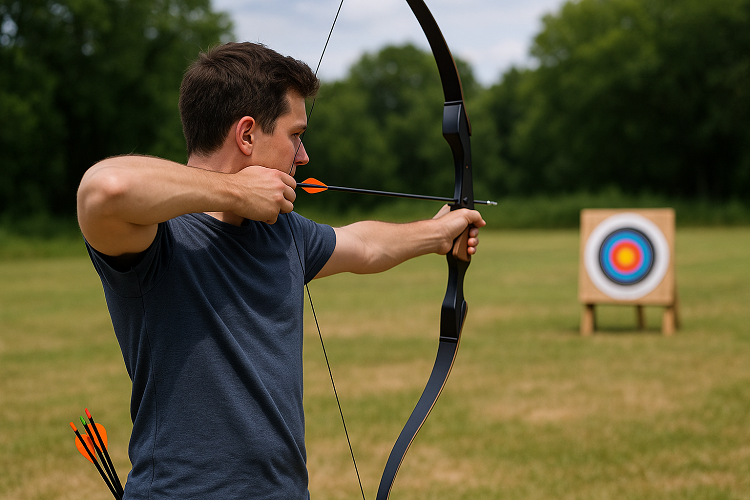Archery is more than just pulling a string and launching an arrow toward a target. It’s a timeless pursuit that blends skill, patience, and fun into a single elegant motion. Whether you’re looking for a new hobby, a family activity, or even a competitive sport, archery has something to offer everyone. In this complete beginner’s guide, we’ll explore everything you need to know to start your archery journey from choosing the right bow to hitting your first bullseye.
So, grab a seat (and maybe a cup of coffee), and let’s unravel the art and science of archery!
Why Archery Is the Ultimate Blend of Skill, Patience, and Fun
Archery is one of those rare activities that balances the body and mind. It’s not just about physical strength; it’s about focus, discipline, and consistency. One moment of distraction can throw off your shot, while a calm, centered mind can make you feel like Robin Hood himself.
What makes archery especially fun is its accessibility. You don’t have to be a pro athlete to pick up a bow. Kids, teens, adults, and even seniors can all enjoy the sport. Whether you want to shoot for stress relief, fitness, or friendly competition, archery is a rewarding and lifelong pursuit. Plus, there’s nothing quite like the satisfying thwack of an arrow embedding in a target it’s pure magic!
A Brief History of Archery
Archery is one of the oldest arts still practiced today. Humans have been launching arrows for at least 10,000 years, using bows for hunting and warfare long before the invention of firearms. Ancient Egyptians, Persians, Greeks, and Chinese all relied on archers, and legendary figures like Robin Hood and William Tell helped romanticize the archer’s image in folklore.
As firearms took over the battlefield, archery evolved into a sport. Today, it thrives in Olympic events, competitive tournaments, and recreational clubs around the world. Whether on horseback in Mongolia or standing at an indoor range in the suburbs, archery’s spirit lives on.
Choosing the Right Bow (Recurve, Compound, Longbow)
Picking your first bow can feel overwhelming with all the choices out there. But don’t worry we’ll break it down:
✅ Recurve Bow
The recurve bow has those distinctive curved tips and is often the first choice for beginners. It’s used in the Olympics and is praised for its simplicity, light weight, and affordability. It’s also a great option for those who want to learn proper form and technique.
✅ Compound Bow
This modern marvel uses a system of cams and pulleys, reducing the holding weight at full draw and allowing for greater accuracy and power. It’s popular with hunters and competitive shooters. While it has a steeper learning curve, many beginners love the techy feel.
✅ Longbow
The longbow is the classic “Robin Hood” style a simple, tall bow with no sights or gadgets. It demands more from the archer but offers a traditional experience that many find deeply satisfying.
Pro tip: Visit a local archery shop or range and test out a few bows. Make sure the draw weight is manageable (usually 15–25 pounds for beginners) and that it feels comfortable in your hands.
Essential Gear and Accessories
Along with your bow, you’ll need a few key pieces of equipment to get started safely and comfortably:
- Arrows: Make sure they’re the right length for your draw and matched to your bow’s poundage.
- Armguard: Protects your forearm from the bowstring slap.
- Finger tab or glove: Cushions your fingers while drawing the string.
- Quiver: Holds your arrows while you shoot.
- Bow stringer: A tool to safely string and unstring your recurve or longbow.
- Target: Foam, straw, or bag targets are ideal for backyard practice.
Optional but helpful gear includes a sight, stabilizer, and arrow puller. As you advance, you can explore tuning tools and advanced accessories but keep it simple at the start.
Step-by-Step Guide to Proper Stance, Grip, and Release
Let’s walk through the basics of a good shot:
- Stance:
Stand perpendicular to the target with your feet shoulder-width apart. Distribute your weight evenly, and keep your knees relaxed. - Grip:
Hold the bow lightly in your non-dominant hand. Avoid squeezing the grip; think of it as holding a baby bird you don’t want to crush it! - Nocking the arrow:
Place the arrow onto the arrow rest and snap the nock (the back of the arrow) onto the string below the nocking point. - Drawing:
Hook the string with your index, middle, and ring fingers (or use a release aid for compound bows). Pull the string back smoothly to your anchor point (usually the corner of your mouth or chin). - Aiming:
Focus on the target. If you have a sight, line it up; if not, use instinctive aiming. - Release:
Relax your fingers and let the string slip away smoothly. Avoid plucking or jerking. - Follow-through:
Keep your bow arm steady and your drawing hand relaxed until the arrow hits the target. This helps maintain consistency.
Common Beginner Mistakes and How to Fix Them
Every archer makes mistakes, especially at the start. Here are a few pitfalls to watch out for:
- Gripping too tightly: Causes torque and inconsistent shots. Keep a relaxed grip.
- Collapsing your stance: Maintain a strong posture and avoid leaning forward.
- Punching the release: Practice smooth, controlled releases.
- Overdrawing: Find a comfortable anchor point and stick with it.
- Neglecting follow-through: Hold your form until after the shot lands.
Remember, it’s perfectly okay to make mistakes. They’re how you learn! Video yourself or ask a more experienced archer for feedback.
Safety Tips on the Range and at Home
Safety is paramount in archery. Here’s what you need to know:
- Always point your bow in a safe direction, even when unloaded.
- Never dry-fire (release the string without an arrow), as it can damage your bow.
- Make sure your target has a safe backdrop like a large net, wall, or open field.
- Inspect your gear regularly for cracks, frays, or defects.
- At the range, follow all rules and commands. Wait for the “all clear” before retrieving arrows.
- When practicing at home, inform family or neighbors and set clear boundaries.
Treat your archery space with respect, and you’ll avoid accidents and build good habits.
How to Stay Motivated and Improve Over Time
It’s easy to feel discouraged if you’re not hitting bullseyes right away. Here’s how to keep your spirits high and your skills growing:
- Set small, achievable goals like grouping arrows tighter or improving your stance.
- Keep a practice journal to track your progress and reflect on what’s working.
- Join a local club to shoot with others and get advice.
- Mix up your practice with games like “closest to the pin” or shooting at different distances.
- Celebrate small wins your first bullseye, a new personal best, or conquering target panic.
Remember, every great archer started where you are now. Consistency beats perfection every time.
Resources: Clubs, Online Tutorials, and Books
There’s a treasure trove of resources to help you learn and grow:
- Local archery clubs: Many offer beginner classes, leagues, and events.
- Online tutorials: YouTube has countless channels for every archery style.
- Books: Check out classics like “Archery Fundamentals” or “Precision Archery” for deeper insights.
- Archery shops: Staff can help with gear selection, repairs, and tuning.
And if you want an easy way to explore beginner-friendly gear, this archery starter kit on Amazon is highly rated and includes everything you need to get going. Investing in good equipment early on can make a world of difference.
The Lifelong Joy of Archery
Archery is more than just a sport it’s a practice in mindfulness, patience, and self-improvement. It connects you to ancient traditions, challenges your body and mind, and offers a sense of accomplishment that few other activities can match. Whether you shoot alone in your backyard or with friends at the range, each arrow teaches you something new.
So, take a deep breath, draw that string, and let your worries fly with the arrow. The bullseye isn’t just a mark on a target; it’s a symbol of focus, persistence, and joy.
Ready to begin your archery adventure? Start with this beginner-friendly archery kit, and you’ll be on your way to hitting the bullseye in no time.



